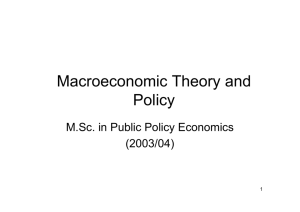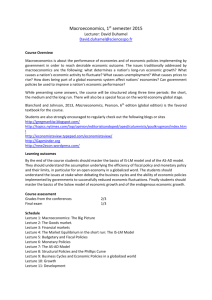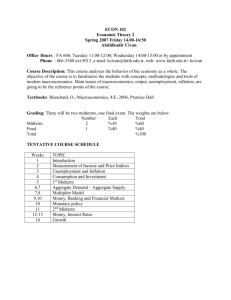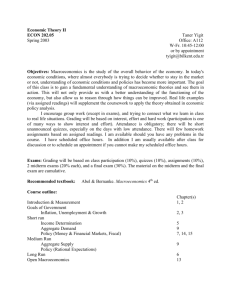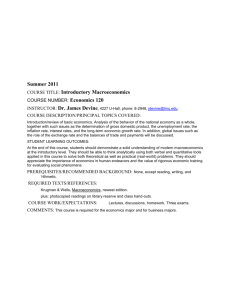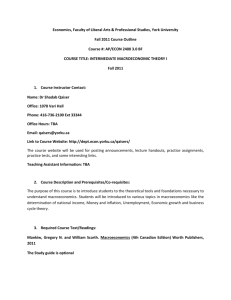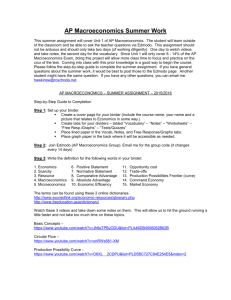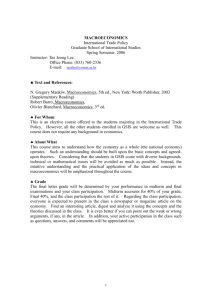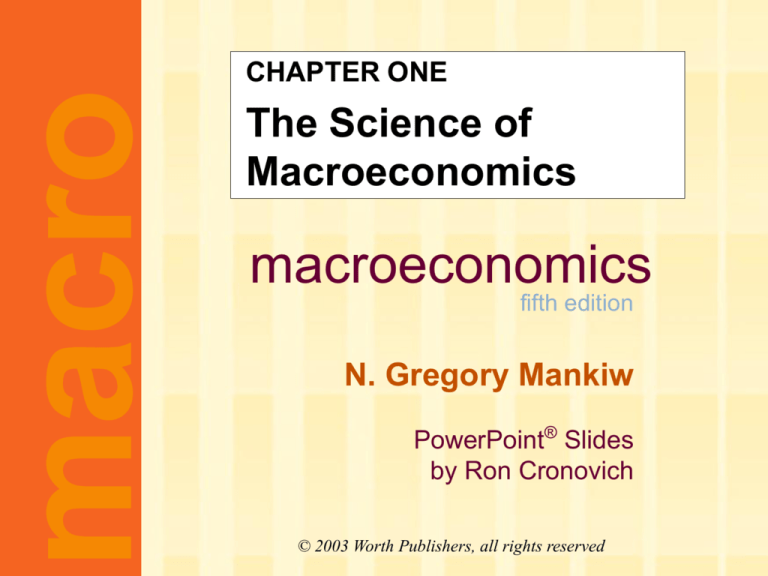
macro
CHAPTER ONE
The Science of
Macroeconomics
macroeconomics
fifth edition
N. Gregory Mankiw
PowerPoint® Slides
by Ron Cronovich
© 2003 Worth Publishers, all rights reserved
Learning objectives
This chapter introduces you to
the issues macroeconomists study
the tools macroeconomists use
some important concepts in
macroeconomic analysis
CHAPTER 1
The Science of Macroeconomics
slide 1
Important issues in macroeconomics
Why does the cost of living keep rising?
Why are millions of people unemployed,
even when the economy is booming?
Why are there recessions?
Can the government do anything to combat
recessions? Should it??
CHAPTER 1
The Science of Macroeconomics
slide 2
Important issues in macroeconomics
What is the government budget deficit?
How does it affect the economy?
Why does the U.S. have such a huge trade
deficit?
Why are so many countries poor?
What policies might help them grow out of
poverty?
CHAPTER 1
The Science of Macroeconomics
slide 3
U.S. Gross Domestic Product
in billions of chained 1996 dollars
10,000
9,000
8,000
7,000
6,000
5,000
4,000
3,000
1970
CHAPTER 1
1975
1980
1985
1990
1995
The Science of Macroeconomics
2000
slide 4
U.S. Gross Domestic Product
in billions of chained 1996 dollars
10,000
longest economic
expansion on record
9,000
8,000
7,000
Recessions
6,000
5,000
4,000
3,000
1970
CHAPTER 1
1975
1980
1985
1990
1995
The Science of Macroeconomics
2000
slide 5
Why learn macroeconomics?
1. The macroeconomy affects society’s well-being.
example: Unemployment and social problems
Each one-point increase in the u-rate is associated with:
920 more suicides
650 more homicides
4000 more people admitted to state mental
institutions
3300 more people sent to state prisons
37, 000 more deaths
increases in domestic violence and homelessness
CHAPTER 1
The Science of Macroeconomics
slide 6
Why learn macroeconomics?
%
2. The macroeconomy affects your well-being.
Unemployment and earnings growth
5
4
3
2
1
0
-1
-2
-3
-4
-5
1965
1970
1975
1980
1985
1990
1995
2000
growth rate of inflation-adjusted hourly earnings
change in Unemployment rate
CHAPTER 1
The Science of Macroeconomics
slide 7
Why learn macroeconomics?
2. The macroeconomy affects your well-being.
Interest rates and mortgage payments
For a $150,000 30-year mortgage:
date
actual rate
on 30-year
mortgage
monthly
payment
annual
payment
6/21/02
6.63%
$960
$11,520
6/20/03
5.21%
$824
$9,888
CHAPTER 1
The Science of Macroeconomics
slide 8
Why learn macroeconomics?
3. The macroeconomy affects politics & current events.
Inflation and unemployment in election years
year
U rate
inflation rate
1976
7.7%
5.8%
Carter (D)
1980
7.1%
13.5%
Reagan (R)
1984
7.5%
4.3%
Reagan (R)
1988
5.5%
4.1%
Bush I (R)
1992
7.5%
3.0%
Clinton (D)
1996
5.4%
3.3%
Clinton (D)
2000
4.0%
3.4%
Bush II (R)
CHAPTER 1
elec. outcome
The Science of Macroeconomics
slide 9
Economic models
…are simplified versions of a more complex
reality
• irrelevant details are stripped away
Used to
• show the relationships between economic
variables
• explain the economy’s behavior
• devise policies to improve economic
performance
CHAPTER 1
The Science of Macroeconomics
slide 10
Example of a model:
The supply & demand for new cars
explains the factors that determine the price of
cars and the quantity sold
assumes the market is competitive: each buyer
and seller is too small to affect the market price
Variables:
Q d = quantity of cars that buyers demand
Q s = quantity that producers supply
P = price of new cars
Y = aggregate income
Ps = price of steel (an input)
CHAPTER 1
The Science of Macroeconomics
slide 11
The demand for cars
demand equation:
d
Q D (P ,Y )
shows that the quantity
of cars consumers demand
is related to the price of cars
and aggregate income.
CHAPTER 1
The Science of Macroeconomics
slide 12
Digression: Functional notation
General functional notation
shows only that the variables are related:
Q d D (P ,Y )
A list of the
variables
that affect Q d
CHAPTER 1
The Science of Macroeconomics
slide 13
Digression: Functional notation
General functional notation
shows only that the variables are related:
Q d D (P ,Y )
A specific functional form shows
the precise quantitative relationship:
Examples:
1)
2)
Q d D (P ,Y ) 60 10P 2Y
d
Q D (P ,Y )
CHAPTER 1
0.3Y
P
The Science of Macroeconomics
slide 14
The market for cars: demand
demand equation:
Q
d
D (P ,Y )
P
Price
of cars
The demand curve
shows the relationship
between quantity
demanded and price,
other things equal.
CHAPTER 1
The Science of Macroeconomics
D
Q
Quantity
of cars
slide 15
The market for cars: supply
supply equation:
s
Q S (P , Ps )
P
Price
of cars
The supply curve
shows the relationship
between quantity
supplied and price,
other things equal.
CHAPTER 1
The Science of Macroeconomics
S
D
Q
Quantity
of cars
slide 16
The market for cars: equilibrium
P
Price
of cars
S
equilibrium
price
D
Q
equilibrium
quantity
CHAPTER 1
The Science of Macroeconomics
Quantity
of cars
slide 17
The effects of an increase in income:
demand equation:
Price
of cars
Q d D (P ,Y )
An increase in income
increases the quantity
of cars consumers
demand at each price...
…which increases
the equilibrium price
and quantity.
CHAPTER 1
P
S
P2
P1
D1
Q1 Q2
The Science of Macroeconomics
D2
Q
Quantity
of cars
slide 18
The effects of a steel price increase:
supply equation:
s
Q S (P , Ps )
S2
Price
of cars
An increase in Ps
reduces the quantity of
cars producers supply
at each price…
…which increases the
market price and
reduces the quantity.
CHAPTER 1
P
S1
P2
P1
D
Q2 Q1
The Science of Macroeconomics
Q
Quantity
of cars
slide 19
Endogenous vs. exogenous variables:
The values of endogenous variables
are determined in the model.
The values of exogenous variables
are determined outside the model:
the model takes their values & behavior
as given.
In the model of supply & demand for cars,
d
endogenous:
P, Q , Q
exogenous:
Y , Ps
CHAPTER 1
s
The Science of Macroeconomics
slide 20
Now you try:
1. Write down demand and supply
equations for wireless phones;
include two exogenous variables
in each equation.
2. Draw a supply-demand graph
for wireless phones.
3. Use your graph to show how a
change in one of your exogenous
variables affects the model’s
endogenous variables.
CHAPTER 1
The Science of Macroeconomics
slide 21
A multitude of models
No one model can address all the issues we
care about. For example,
If we want to know how a fall in aggregate
income affects new car prices, we can use
the S/D model for new cars.
But if we want to know why aggregate
income falls, we need a different model.
CHAPTER 1
The Science of Macroeconomics
slide 22
A Multitude of Models
So we will learn different models for studying
different issues (e.g., unemployment, inflation,
long-run growth).
For each new model, you should keep track of
– its assumptions,
– which of its variables are endogenous and
which are exogenous,
– the questions it can help us understand,
– and those it cannot.
CHAPTER 1
The Science of Macroeconomics
slide 23
Prices: flexible versus sticky
Market clearing: an assumption that prices
are flexible and adjust to equate supply and
demand.
In the short run, many prices are sticky--they adjust only sluggishly in response to
supply/demand imbalances.
For example,
– labor contracts that fix the nominal wage
for a year or longer
– magazine prices that publishers change
only once every 3-4 years
CHAPTER 1
The Science of Macroeconomics
slide 24
Prices: flexible versus sticky
The economy’s behavior depends partly on
whether prices are sticky or flexible:
If prices are sticky, then demand won’t
always equal supply. This helps explain
– unemployment (excess supply of labor)
– the occasional inability of firms to sell what
they produce.
Long run: prices flexible, markets clear,
economy behaves very differently
CHAPTER 1
The Science of Macroeconomics
slide 25
Outline of this book:
Introductory material
Classical Theory
(Chaps. 1 & 2)
(Chaps. 3 to 6)
How the economy works in the long run,
when prices are flexible
Growth Theory
(Chaps. 7 to 8)
The standard of living and its growth rate
over the very long run
Business Cycle Theory
(Chaps 9 to 13)
How the economy works in the short run,
when prices are sticky
CHAPTER 1
The Science of Macroeconomics
slide 26
Outline of this book:
Policy debates
(Chaps. 14 to15)
Should the government try to smooth business
cycle fluctuations? Is the government’s debt a
problem?
Microeconomic foundations
(Chaps. 16 to 19)
Insights from looking at the behavior of
consumers, firms, and other issues from a
microeconomic perspective
CHAPTER 1
The Science of Macroeconomics
slide 27
Chapter summary
1. Macroeconomics is the study of the
economy as a whole, including
• growth in incomes,
• changes in the overall level of prices,
• the unemployment rate.
2. Macroeconomists attempt to explain the
economy and to devise policies to improve
its performance.
CHAPTER 1
The Science of Macroeconomics
slide 28
Chapter summary
3. Economists use different models to
examine different issues.
4. Models with flexible prices describe the
economy in the long run; models with
sticky prices describe economy in the short
run.
5. Macroeconomic events and performance
arise from many microeconomic
transactions; so macroeconomics uses
many of the tools of microeconomics.
CHAPTER 1
The Science of Macroeconomics
slide 29
CHAPTER 1
The Science of Macroeconomics
slide 30


